The League of Gentlemen's Apocalypse is replete with references to films and little in-jokes for Gents Fans. This file is an attempt to bring those together. At the moment, all these references are taken from memory, from fans who have seen previews of the film. If there are mistakes, they are for this reason.
Authors
This file was created by members of The King's Evil Yahoo discussion group and edited by a1tiptop.
Section 1 - The Real World
1.1 The lighthouse
The lighthouse and coast bit at the start may be a reference to the start of The Fog (1980). The scarecrow could be a nod to the sketch in the League's Series 1 where Farmer Tinsell imprisons Mr Ward as a scarecrow in his field.
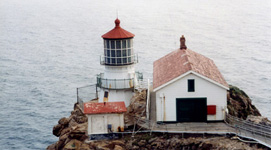
1.2 The dramatic mobile phone ringtone
The same music is used twice in the film to misdirect the viewer into thinking something scary was about to happen. Both times it is revealed to be a mobile phone ringtone - at the start (Jeremy's) and then just before Hilary calls from Hadfield (Reece's). The ringtone is actual a variation on Joby Talbot's theme music of the League of Gentlemen's TV series.
1.3 What about if one day all the characters wake up and… they've got tails!
Aside from the payback to this at the very end of the film, where Jeremy's idea is realised while he's in the coma, this could possibly be a reference to Tubb's and Edward's habit of referring to men as "tails" and women as "no-tails".
1.4 Grandmother's footsteps
When Jeremy is he closing his eyes saying 'you're not real' and Tubbs and Edward stop walking until he opens his eyes again, this is possibly a reference to Dr Carlton's creeping game (Grandmother's footsteps) Series 3, episode 1.
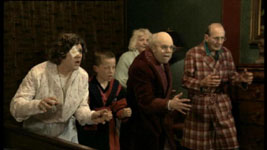 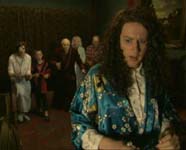 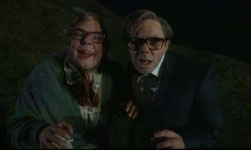
1.5 Fictional characters going after their creators.
This has a number of different reference points. The production notes specifically mention Stephen King's book The Dark Half (1989).
In the SFX (June 2005) interview, Reece Shearsmith also quotes Wes Craven's New Nightmare (1994) as being a direct inspiration for the plot of Apocalypse. In it, the fictional character Freddy Kreuger, upset that he was killed off in the last "Nightmare on Elm Street" movie, attempts to murder his creators and actors from his previous films.
In the same SFX interview, Mark Gatiss quotes Murder by the Book (1986) where an elderly Agatha Christie is confronted by her fictional creation, Poirot, who she has just killed off in her latest book.
Another references is Six Characters in Search of an Author (Sei personaggi in cerca
d'autore) (1925), the most famous work of Italian playwright Luigi Pirandello. Mark and Steve talked about this in the Richard and Judy interview. In the play, the audience is confronted with the unexpected arrival of six characters during the rehearsals for a play (incidentally, one of Pirandello's own) and insist on being given life, on being allowed to tell their story. There is also an episode of Twilight Zone called "Five Characters in Search of an Exit".
1.6 Fictional characters becomming self-aware
Mark firmly cites the journey that Buzz Lightyear takes in Toy Story (1995) as being a key influence for this. Although Reece claims never to have seen the film!
Interestingly, the scenes where characters met characters who were played by the same Gent, or met one of the "real" Gents, were particularly challenging to create. An article with Framestore - the company that did the special effects for Apocalypse, said:
"The trickiest multiple shot was a four-way split screen which featured three Reece Shearsmith characters plus one Steve Pemberton. But the fact that they are such expert performers and so on top of the material made the job of making it look completely convincing that much easier."
1.7 The "real" League of Gentlemen
Much of the League of Gentlmen's "real lives" as presented in Apocalypse are made up or exaggerated. Lindsey (played by Emily Woof, shown below with Herr Lipp-as-Steve) is obviously not Steve's real wife, nor are the children (also shown below) Steve's real kids (he only has two in real life). The League are portrayed as quite harsh, unsympathetic "characters" in order to make us care more about the Royston Vasey heroes of the film. "We tried to distance ourselves as much as possible," says Mark Gatiss (SFX, June 2005). "Ultimately we're baddies through sheer indifference to our creation."
 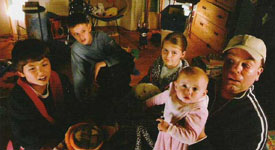
For an insight into the Gents real lives, fans might like to watch the behind the scenes documentary and video diaries on the Series 3 DVD (2003).
Jeremy Dyson doesn't usual appear on camera very often - an allergy to halogen lighting, he famously joked. The reason is really because Jeremy doesn't consider himself a trained actor. For an example of Jeremy's early attempts to prove this, check out "Highgate House of Horror" - a short film made by the League early in their career, snippits of which can be found on The Christmas Special DVD (2002). In the Apocalypse, the part of "Jeremy Dyson" is played by an actor, Michael Sheen.
 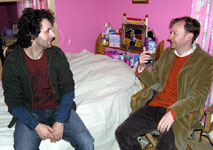
1.8 Filming and Locations
The film cost £4.1 million (including tax breaks due to the film being mostly recorded in Ireland), and is a co-production of Universal Pictures and Film Four. "There's a yardstick in British film-making whereby if it costs more than £3.5m to make, it's considered uneconomic," says Peter Bennett-Jones, the film's executive producer and chairman of co-production company Tiger Aspect. "So I managed to raise that figure from Film Four and Universal and then put up the other £750,000 through Tiger Aspect."
The production was based in Dublin for six weeks of filming, which has easy access to specific locations:
- County Wicklow (an hour south of Dublin) was where many of the scene supposed to be set in Hadfield or Royston vasey were filmed (except below).
- Bernice's church is actually the church of the Saints Mary and Patrick in Avoca, County Wicklow. The church is renamed to "Holy Trinity, Hadfield" for the Real World part of the film.
- The Arcade where Papa shows Hilary, Geoff and Herr Lipp the video of themselves is filmed by the sea in Bray, County Wicklow.
- An island off the coast of Ireland, at a lighthouse (source:Sunday Mag) - was where all the scenes around Jeremy's house were filmed.
- The beautiful house and gardens used in The King's Evil section of the film is actually Powerscourt Gardens. The grounds have been used in many films, including The
Abduction Club (2002) & the waterfall there was rumoured to have been used in Excalibur (1981).
Two days of filming were done in and around Hadfield, Derbyshire, using the same locations as the TV Series:
- H. Briss Butchers - Merrick's Butchers, Hadfield ~ Station Road
- The War Memorial - The Cenotaph, Hadfield ~ Station Road
- Geoff's flat - same location as Series 3 - Winston Mews, Gamesley, near Glossop.
Some filming was done in London.
- The London Eye (South bank) - Hilary and Herr Lipp's meeting
- Soho Square - MDF offices and "hide" where Hilary, Herr Lipp and Geoff spy on Reece/Steve/Mark.
- Oxford Street - Herr Lipp's walk down Oxford Street was filmed in a single day.
- East Finchley - All the "survellance" shots of the Gents are filmed in East Finchley and you can clearly see the tube station behind them in some photos. East Finchley's "local cafe" can be seen when Papa explains to Hillary, Herr Lipp and Geoff about their fictional status.
Chinnery's Giraffe section was filmed at Oxford Zoo over the course of a single day.
1.9 Hadfield - a mecca for fans
It is actually true that fans [used to] have conventions in Hadfield, where the majority of the TV series was filmed. And some even dress in fancy dress. There is no Herr Lipp fan club though. The most popular fancy dress is Papa Lazarou.
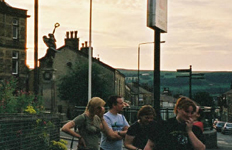 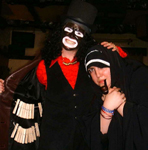
1.10 Geoff's flat
The fountain picture in Geoff's flat is the one that was in Spit and Polish (Series 3) and in the DVD commentary Reece said he had it in his house but didnt know where to put it. Well now it's on Geoff's wall.
1.11 Tubb's foods
When Papa coughs up the hairball, Tubbs makes a face as if she'd like to eat it. This is a reference back to Tubb's hair sandwiches from Series 1.
Tubb's "Little Brown Fish" comes from the idea that before entering the Real World, none of the characters would have ever have gone to the toilet. At least, that's what the League said during an interview with Richard and Judy. But many Royston Vasey characters certainly do go to the toilet - see the discussion on NOTBBC if you want a list!
Of course, Tubbs had previously serves "shit dips" (a stage direction taken far too literally) at the wedding of David and Barbara (Series 2).
1.12 MDF Management
The League of Gentlemen's real management company is called PBJ Management. MDF stands for medium density fibreboard, a kind of cheap wood used in DIY and home improvement TV shows. PBJ Management is situated in Soho Street, just off Soho Square, which was used as the location of MDF in the film. (see Locations).
Various posters can be seen around the office, some of which are films in which various Gents play minor parts - for example, Churchill the Hollywood Years (2004), in which Steve Pemberton has a cameo.

1.13 Mr Bean
The Bean (1997) film poster really does hang on the walls of the PBJ offices and provides a wonderful bonding moment for Geoff and Herr Lipp.
Geoff mentions Unseen Bean (1995) and the episode where Mr Bean gets a Turkey stuck on his head, which can be found on Mr Bean (1996).
The lobby poster for 'Bean: The Ultimate Disaster Movie', featured in the PBJ building and the film, is actually the American poster. The UK one featured Mr Bean nicking the letter O from the Hollywood sign.
 
1.14 Geoff finds a Neil Sedaka CD in the Gent's MDF office
Steve and Reece are huge fans of Neil Sedaka, having seen him play live several times. A Neil Sedaka compilation album was played to fans while they waited for the Gents Local Show Live Tour to begin. Steve and Reece also went on VH1 choosing their "10 of the best" pop videos of all time - one of the ten was Neil Sedaka playing "Breaking up is hard to do". There is also a reference in the Christmas Special where someone has been hypnotised to "eat and onion as if it were an apple" every time they hear Neil Sedaka.
The CD that Geoff finds is Laughter and Tears (1993)
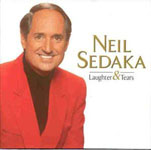
1.15 We're not doing a Heist film!
There are many references in Apocalypse to the pit falls of doing a spin off film from a TV series. Many of these are real films! The first is Mark talking to Reece in the MDF offices, talking about his objection to doing a "heist" film.
There were three Monty Python-related comedy heist movies that came out at around the same period in time - A Private Function (1984), A Fish Called Wanda (1988, and referenced itself
in the Christmas special), and Nuns On The Run (1990).
The list of ideas the Royston Vasey residents come up with at the end is another example of this. The specific references are:
- Pauline's 'going on holiday' suggestion seems to refer most explicitly to the film, Are You Being Served (1977), though Carry On Abroad (1972) and One Foot In The Algarve (1993) are two more that may have been on the League's minds at the time.
- The 'mobster' suggestion is a specific reference to the two-part Only Fools and Horses Christmas special from 1991, Miami Twice.
- "A Carry On but with spacemen" - this is a reference to 'Carry On Astronaut', an unfinished film script Talbot Rothwell began writing and one of the unmade Carry On films of the 1970s.
1.16 Herr Lipp's audition
Liam Cunningham has a very brief cameo as the director of the film that Her Lipp ends up auditioning for. As well as being a fairly well known actor in films & TV he has also directed some television and adverts in Ireland, which was possibly why he was approached for this role. Another is that one of his films is War of the Buttons, and that is listed as Henry Portrait's weariest film on the series 1 dvd character profiles.
1.17 Animal masks
The masks Hilary, Geoff and Herr Lipp wear are of a sheep, a pig and a cow. This is probably a reference to the to the oft-quoted Gent favourite film The Wicker Man (1973) where the Summerisle residents parade wearing animal masks.
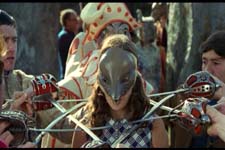
While the masks are covering the Gents faces, the only part which is actually a stunt double is where Geoff is hanging from the ceiling. The chase sequence over the desk is the real Gents and resulted in a number of barked shins as it had to be filmed many times - much to the chagrin of Mark - "You can't even tell it's us!"
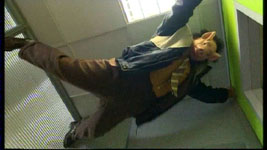
1.18 The Overlooked Hotel
"The Overlooked Hotel" where Hilary and Geoff hold Steve Pemberton captive is a reference to The Overlook Hotel from Stephen King's The Shining (1980, Warner). The look of the Dentons House is based on it. When Steve is trying to escape the hotel, he briefly glimpses a pig giving a blow job in another room. This is also a reference to the Shining.
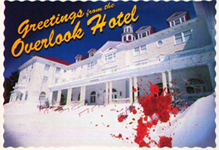
Also, the pig says "Come on in if yer coming" - a line also said by Reece in the "UK Play Links" - a series of specially filmed "links" set in Clerkenwell House of Detention that were shown on the now-defunct UK satellite channel "Play" in May 2000.
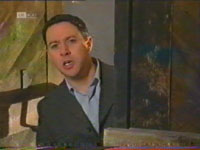
1.19 It's not the Roswell incident!
Hilary's line refers to the place in the USA where a UFO crashed (if you believe conspiracy theories) in July 1947 and an autopsy was carried out on an alien to determine if it was, or wasn't a hoax.
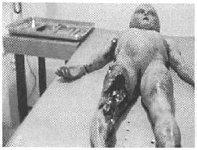
1.20 You've never seen The Evil Dead?
Geoff likens their situation to the film Evil Dead (1981), Directed by Sam Raimi, which Steve Pemberton claims (Geoff: "The bit where them twigs go up her fanny...!") not to have seen. The film is famous (infamous) for a scene where a young girl is raped by a demonic tree! Interestingly, the bit in Series 3, where Lance cuts off his arm, is from Evil Dead 2.
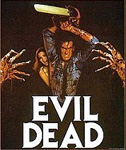
1.21 The London Eye meeting
When Hilary and Herr Lipp meet on the London Eye wheel, this is reminiscent of the meeting between Martins and Harry Lime (the cuckoo clock speech) in The Third Man (1949), also on a ferris wheel. Interestingly, the ferris wheel from the Third Man is the Riessenrad Big Wheel in Vienna's Prater amusement park.
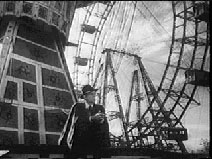
1.22 League Memorabilia
Jeremy and Steve seem to have a lot of League memorabilia in their houses (although all photos are cleverly doctored to substitute Michael Sheen for the real Jeremy Dyson). In Steve's spare room, you can clearly see a Precious Thing (Snow Globe given away free with Series 1 VHS, goes on ebay for up to £50), The Local Shop biscuit tin (given away with the Christmas Special VHS), a Charity Shop Bag (given away at the Scripts and That signings) and the 2004 League of Gentlemen calendar. There is also a Royston Vasey stick of rock.
There is also some memorabilia in Jeremy's house. Aside from the Series 1 DVD (on which he draws tails) there is also a poster for the Local Tour of 2000-2001 and statuettes of Tubbs, Edward and Hilary Briss.
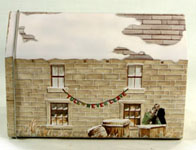 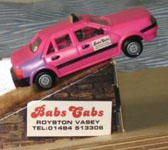 
1.23 Cut scenes
In the trailer for the film there is a clip where Tubbs says "Gooble Gobble" and Papa says "Calm down dear" but this bit is missing from the final film! There was about 20 minutes of the film cut at the final edit, according to Steve Pemberton (the Phoenix Cinema preview Q&A). This scene, cut for pacing, will turn up on the DVD as a deleted scene. Tubbs' dialogue is actually a reference to the chanting scene ("Gooble Gobble - One of Us!") at the dinner table in the film Freaks (1932) which was already heavily referenced in Seriese 2 Episode 1.
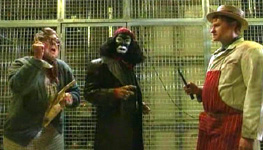 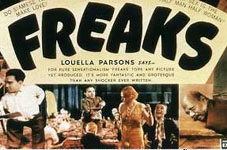
Originally in an early draft of the script, there was a whole subplot featuring Pauline and Mickey. Unfortunately only the glimpse of those two characters at the start of the film remains of this section.
Also in an early draft of the script, Mark Gatiss was going to be revealed at the end to be the villain and in league with Doctor Pea. He also had a glamourous Danish Supermodel wife!
1.24 Mongs
Reece's refers to "mongaloids" regarding the charity event when on the phone to Steve. This is a reference to the complaint that was made (and upheld) against the Christmas Special, where Bernice uses the word "mong". This word was then cut from all subsequent broadcasts of the Christmas Special.
1.25 Reece's house
Reece's house has several things worth of note. First there's the large piece of artwork showing 9 of Reece's League characters (including Edward Tattsyrup, Judy Levinson, Terry Lollard, Papa Lazarou, Joesph Nigel Lisgoe, Ross Gaines, Henry Portrait, Olive Kilshaw, Judith Buckle). There's also an old picture of the League from the BAFTAs that's been doctored to include Michael Sheen. Finally, there are five widescreen TVs on Reece's wall - not quite sure why he needs five, but hey!
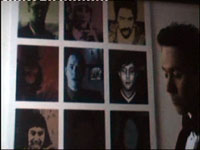 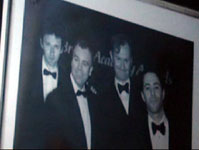
1.26 Guess Who
Herr Lipp-as-Steve is playing the popular children's game "Guess Who" (by toy manufacturer Hasbro) with his son.
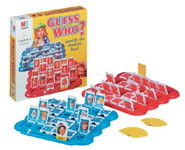
1.27 Mark catches Herr Lipp out by speaking German
A reference to the film The Great Escape (1963). One of the escapees from the prison camp, Flight Lt. Sandy MacDonald (played by Gordon Jackson) is about to board a bus for freedom disguised as a German civilian. A suspicious Gestapo Officer questions him but lets him go. Just as he's boarding the bus, the officer calls out to him "Good luck" in English. MacDonald unwittingly responds in English with "thank you". D'oh!

1.28 Jeremy's Cameos
Like Hitchcock, Jeremy has regular cameos in their work. You can see a comprehensive list of these on the LoG Character Website, but here's a summary.
- Series 1 Episode 4: Jeremy's character, "Shabsy", buys a lighter from Les McQueen
- Series 2 Episode 5: Jeremy is Dorian, Les' replacement on rhythm guitar in Creme Brulee
- The Christmas Special: Jeremy plays a student to breaks his glasses, making a noise that interrupts Chinnery's delicate operation.
- The Christmas Special: Jeremy is in the line of people waiting to see the newly-cursed Dr. Edmund Chinnery. He is holding a duck.
- Series 3 Episode 3: Jeremy is a heckler in the audience for Geoff Tipps' debut performance. His line is "Get off then".
- Series 3 Episode 5: Jeremy is Stella's councillor, who also has a thing for slot machines. His line is, "Not bothered, not bothered."
- Series 3 Episode 6: Mr Griffin, the man on the ladder who uncovers Siepp's Cat Theatre sign
Jeremy also frequently body-doubles for Reece while he is off filming other characters, because they are a similar height and build.
In Apocalypse, the "real" Jeremy's cameo comes right at the very end of the film where the faux Jeremy is in a coma in his hospital bed. He's an orderly who you see push a trolly across the frame. He has "The biggest tail" according to Mark Gatiss.
1.29 Alternative endings
There were several alternative endings to the film pitched but rejected.
- At the end, Mark, Reece and Steve are at Jeremy's bedside in the hospital and say the "We wonder what's keeping him going" line, before switching off his life support! Reece really wanted to do this one.
- At the end, the Doctor in the hospital at Jeremy's bedside turns out to be Doctor Pea! And he turns off Jeremy's life support.
1.30 Other ideas for the film
The League have talked about other ideas that never made it into the film.
- Mark: We started with an idea about a haunted theatre, but it was like a Christmas special – with lots of little stories interlaced. Our ambition was always to write a longer narrative and this idea got us excited.
- Steve: We did have the idea of everybody having tails – which was Jeremy's idea – but it didn't sort of develop. It is in the film, though. We may do it in the future.
- Mark: We had it in an early draft where Hilary, Geoff and Herr Lipp were chosen to go on the mission by the rest of the town and there was this big ceremony and Geoff said: "What do we have to do again, I wasn't really listening?"
Section 2 - Royston Vasey
2.1 Hilary's entrance
The first Hilary scene where he is struggling across the moors wearing shackles, is most likely a reference to Dickens' Great Expectations, and the convict Magwitch. Mark is a huge fan of Dickens - his Doctor Who episode "The Unquiet Dead" was set at the end of Dickens' life.
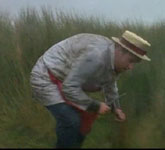 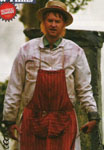
2.2 When is the film set in the continuity of the series?
It isn't! The film was confirmed to be "a bubble, like the Christmas special" at the Phoenix Q&A.
- The characters are portayed as fictional characters - outside any timeline.
- And/Or the characters are Jeremy's interpretion - part of Jeremy's coma/subconscious. Even at the end, the nurses have tails, linking to Jeremy's suggestion of tails as a possible plot for Royston Vasey at the very beginning of the film. This suggests that the entire film (including the bits with the supposed "real" League of Gentlemen) was played out in Jeremy's coma.
2.3 Mickey flying his dog like a kite
This is similar to Winnie the Pooh and the Blustery Day (windsday). In it, Piglet flies away- Pooh catches him by the jumper, which unravels, so Piglet is hanging on for dear life in the air as Pooh hangs onto the string. Kanga comes out to see the commotion with Roo, who exclaims 'Look Mum look, a kite! Can I fly Piglet next, Pooh?'
2.4 Bernice's church
The scaffolding around both Bernice's church and the "Real World" church must surely be a reference to one of the League's favourite films Don't Look Now (1973) where Donald Sutherland (playing John Baxter), is helping to restore an old Venician Church and falls from the scaffold.
The League have already referenced Don't Look Now several times in their series (particularly in series three where Mickey spills his paint in Episode 1, and Papa's assistant attacks Reenie in Episode 6).
As possibly was the crypt with the friezes on the wall, although that was also a reference to a bit in The Omen (1976), where Leo McKern tells of a prophecy just as Bernice does in the film.
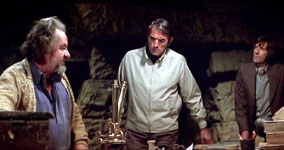
2.5 What is this? The Name of the Rose?
Pauline is referring to the film The Name of the Rose (1986), from the book by Umberto Eco, where a Monk (Sean Connery) investigates a death and there's quite a few scenes in catacombes and crypts. Rather like Cadfael, but American.
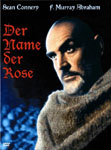
2.6 One of the three keys of Ingress
Ingress, of course, means "A means or place of entering". In this case, entering alternative realities, both the "real world" and others. The reason Geoff is able to write himself into the Kings Evil later on is that he's left the key on top of the computer.
2.7 The white room
The small white room where Hilary, Geoff and Herr Lipp go into in the basement of the church, is where they "change realities" (signified by the flickering lightbulb). This could me a nod to Kubrick's 2001: A Space Odyssey (1968) where Dave Bowman finds himself in a "white room".

2.8 Reece and Mark climbing the scaffold.
The characters talk about the climb being like The Poseiden Adventure (1972) and Reece comments that as long as he's "not the fat one who drowns" (Mark replies "Shelly Winters?") just before falling to his death.
Reece says, "We're playing with all the films and genres that we've always enjoyed. The Poseidon Adventure's in there. In fact, we wrote a scene with us in tuxedos just so we could have our ties undone and sooty faces. It's a kind of a dream come true. We ticked all the boxes of the things that we'd have loved to have been in - and now we are!"
 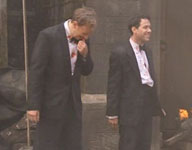 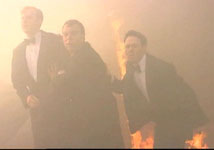
Steve says: "We were really influenced by a lot of action-movie stuff, disaster movies really, while writing Apocalypse. Predominantly, The Medusa Touch (1978) really springs to mind. We were filming in a church and all remembered the great scene of the cathedral crumbling at the end of The Medusa Touch with all this polystyrene squashing actors like Harry Andrews. And we’ve got this thing with tuxedoes, we always performed in tuxedos when we were in Edinburgh… so the original ending to the script has the writer characters running through, and we said, let’s put them in tuxedoes so we can have open, frilly shirts with the bow ties hanging loose and then immediately you ’re in The Poseidon Adventure or The Towering Inferno. And things like that fed into it all the way through. We really, really enjoyed drawing on films that we love, and there’s elements of Carry On and elements of Hammer horror…"
2.9 The Wizard of Oz
Steve Pemberton references The Wizard of Oz (1939) in that the characters go looking for a god-like creator but behind the curtain there's just a man working the levers. "Essentially that's us. Sorry," He says, "we aren't these grotesque characters. We're quite ordinary really." There is even a direct reference to The Wizard of Oz in the film, where Hilary says "Come out" and the Royston Vasey residents emerge from behind the gravestones to meet their creators. This is mirroring Glenda in Wizard, saying "Come out, come out" to the munchkins, in order to meet Dorothy.
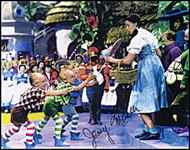
2.10 The clown with leprosy
Grok, the clown with leprosy, is originally a "Porn Dwarves" character.
The Porn Dwarves was the spoof name for the League of Gentlemen (the writers) themselves, used in the Local Book in the first Royston Vasey Chronical (The Local Man Lines Pockets article). The clown with leprosy is mentioned in this article.
Although in reality, the name "The Porn Dwarves" was, of course, what Steve Pemberton originally wanted to call the League of Gentlemen, but he got out-voted.
The clown's name was revealed in Jeremy's photo diary.
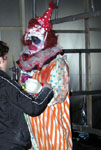
2.11 The League of Gentlemen - extraordinary!
This line from the film is very obviously referring to the Alan Moore graphic novel-turned film The League of Extraordinary Gentlemen (2003).
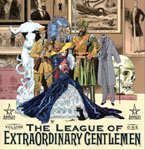
2.12 Head explosion
The bit where Father Halfheart shoots Steve's head off and it literally explodes is, of course, a homage to David Cronenberg's film Scanners (1981), where Michael Ironside's head explodes.
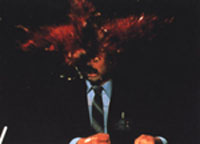
2.13 Incorrect! Frankenstein!
When Reece complains that they can't be killed by their creations, Mark says "Incorrect!" in a reference to the Henry and Ally sketches from the TV series.
Frankenstein (1818) is a novel by Mary Shelly, but was made into a film, and remade several times, most notably by James Whale in Frankenstein (1931). Mark Gatiss has written an autobiography of James Whale (1995).

2.14 Chinnery and the rabbit
Right at the end of the film, Chinnery finds a lop-eared rabbit on the church pew and holds it up. This is a reference back to the Christmas Special, where Chinnery's ancestor operated on a similar rabbit, then subsequently killed it. In fact, the music from the operation scene is played in Apocalypse as Chinnery holds up the rabbit.
Section 3 - The King's Evil
3.1 The King's Evil
Very probably a reference to The King's Men by Christian Fall (1997), an adult novel widely regarded to have been written by Mark Gatiss using a pseudonym.
3.2 What know you of the 1690s period?
There's a complex set of references around this. The Gents are a fan of that period and performed what is known as "wiggy Johnny-go-go-go-go" aka Sir Quincy in their Live at Drury Lane DVD. This in turn was adapted from the original sketch turned into a full length Doctor Who audio play written by Mark called Phantasmagoria (1999). This in turn is hugely influenced by Blood on Satan's Claw (1970, Tigon), where some of the dialogue is directly taken from ("To his majesty King James. May he live long, in exile").
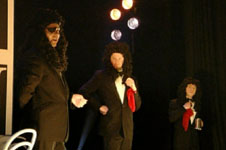
Lemuel Blizzard's appearance is an overt reference to Blood on Satan's Claw - the wig and ruddy face (made more extremely purple!) is based on the character of the Judge (Patrick Wymark), which in turn inspired the look of Sir Quincy Styre from Live and Drury Lane.
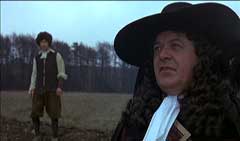 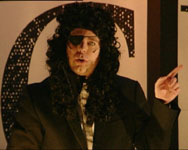 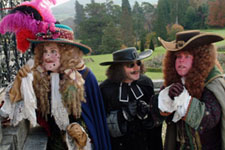
Lemuel Blizzard is, in fact, not the character's actual name - he is called Ponsonby Snottington-Smythe, as Geoff spots when he reads the script.
Mark has stated that the King's Evil section is directly influenced by Peter Greenaway's The Draughtsman's Contract (1982) in terms of the idyllic "Restoration era" setting, extravagant costumes and enourmous wigs. Lemuel Blizzard's plans "involving wigs" are a reference to this. Also in Sir Quincy, the opening music is also the music to The Draughtsman's Contract.
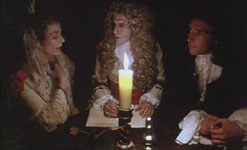 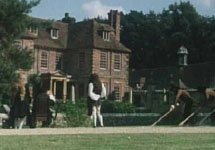 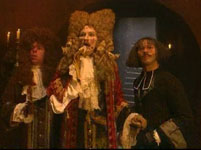
Also, Witchfinder General (1968, Tigon), a companion piece to Blood on Satan's claw, was also a reference point for the era.
Regarding general film influences, Steve says, "This film is all about writing and even filmmaking. In many ways it's our love letter to cinema.
3.3 Door knocker
The scene with the human door knocker if very similar to the scene in Labyrinth (1986). The doorknocker is trying to speak to the Sarah and can't because he has his mouth full. She removes the ring, he's relieved because it's been in his mouth for years. They have a conversation, and then she puts the ring back in his mouth. This character was actually invented by Terry Jones, the screen writer of Labyrinth. Jim Henson says in the production notes "Terry would sit down with a whole batch of Brian Froud's drawings and come across a character he particularly liked,. For example, Brian sketched a few door knockers. They were faces -- one of which had a large ring in his mouth. Terry wrote him into the script as a character who tries to talk but can only mumble because he has this ring in his mouth."
 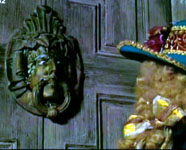
3.4 You need hands... and feet... and an arse...
The hands protuding from the walls are rather like those in Cocteau's Le Belle et la Bette (1946).
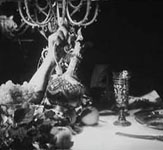
The idea of the hands and feet which are revealed to be servents has been used a lot since Polanski's Repulsion (1965).
3.5 Doctor Pea
This is possibly a reference to the Elizabethan alchemist Dr John Dee (1527-1608) who believed he could talk to spirits and demons. Although, unlike David Warner's character, he wasn't turned into a Pea when he died...
3.6 The creature's got to see, sweetie!
The removal of Father Halfheart's eyes could well be a reference to Shakespeare's play King Lear. In King Lear, the Duke of Cornwall ties the Earl of Gloucester to a chair and plucks his eyes out for
supposedly being a traitor (and says "out, vile jelly!"). It's nice and gorey onstage.
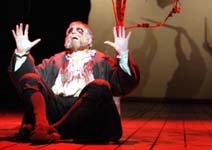
3.7 Humunculus (Homunculus)
According to the Apocalypse soundtrack CD, the spelling used in the film is humunculus. But both spellings are acceptable and used interchangably in literature, although Doctor Pea says "humunculus", Geoff seems to say "homunculus" and both have been used in interviews! Make of that what you will...
According to Dictionary.com: A person who is very small but who is not otherwise deformed or abnormal. It's actually Latin for "little man". However, according to The Encyclopedia of Mind, Magic & Mysteries by Francis X King:
"There are many references to the homunculi, the man-made men of ancient alchemy, dating from Arnold of Villanova in the 13th century, to Count John Ferdinand of Kufstein, in the Tyrol, in the 18th century. In "Frankenstein", the misguided doctor develops his perverted interest in natural science through reading the works of Paracelsus, a 16th-century alchemist. Paracelsus is perhaps the best known "manufacturer" of a humunculus. He claimed to have successfully "grown" a human from a man's semen, which he had sealed in a jar and then "magnetized" by burying it in horse manure for forty days, after which it resembled human form. The humunculus, he tells us, should then be kept at the constant temperature of a mare's womb for forty weeks, during which time it should be fed on human blood until it grows into a normal human child. It is claimed that some anicent alchemists and philosophers were born in this manner."
Clearly Dr Pea's method is rather more prompt than Paracelsus'!
Also, homonculi are the main subject of the book by Dennis Wheatley, To the Devil a Daughter (1969).
The word humonculous is also used in Asylum (1972). Herbert Lom builds them. The League were hugely influenced by Asylum and other Amicus Portmanteau Horror Films for their Christmas special.
The raising of the homunculus could also be a reference to the Christopher Lee film The Devil Rides Out (1968, Anchor Bay). In fact, Reece plays a tiny, rather pathetic, red devil.
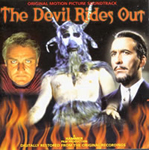 
The collection of body parts for the homunculus is likely to be a reference to Blood on Satan's Claw where a creature is made by growing bits of it on the bodies of children in a village. Mark, Jeremy and Reece provided the commentary to this film on the recent Tigon Box Set and joked about the different body parts needed ("The Devil's eyebrows!" - as illustrated in the picture)
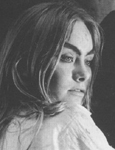
3.8 Stop motion effects
The animation effects of both the initial homunculus and the three-headed one are done in a style known as "stop motion animation" - pioneered by the legendary Ray Harryhausen in such films as Sinbad and the Eye of the Tiger (1977) and Jason and the Argonauts (1963), allowing the heroes of such films to fight monsters and skeletons.
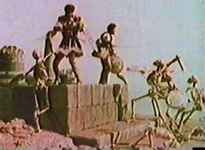 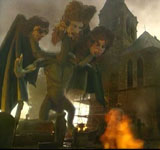
3.9 Caliban
Dr Pea refers to the monster as a "wretched Caliban" (actually about him being
poisoned, so "this wretched Caliban's hide").
Caliban is Prospero's servant in Shakespeare's play The Tempest, a "freckled whelp, hag-born—not honoured with a human shape".
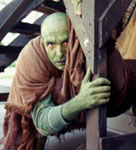
3.10 Cameos
David Warner, who plays Erasmus Pea in Apocalypse, has appeared in many horror and science fiction films, notably The Omen (1976), and has also previously worked with Mark, playing Doctor Who in Doctor Who Unbound: Sympathy for the Devil (2002) against Mark's The Master, and also as a villian in BBC Radio 4's Nebulous (2005). Reece is a particular fan of The Omen (see In Conversation With on the Christmas Special DVD), and quizzed David on his famous decapitation scene while filming Apocalypse.
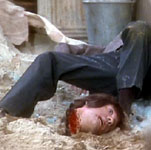 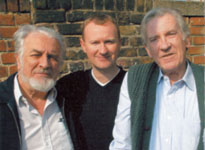 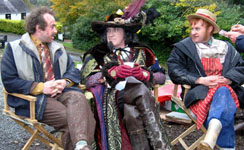
Victoria Wood, who plays Queen Mary II in Apocalypse is another favourite of the Gents. In fact, they appeared at Victoria's BAFTA tribute with all four Gents giving their own personal homage to her. Bernard Hill plays King William III in Apocalypse. Reece says "Bernard was very serious in Lord of the Rings but he's very funny in this. They make a great couple."
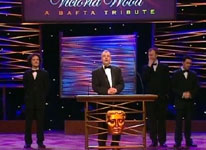 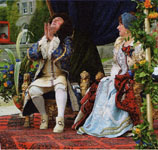
Simon Pegg and Peter Kaye have fleeting, but very funny, cameos in the film. Simon plays "Peter Cow" and Peter plays "Simon Pig" although you'll only know that if you read the credits. Simon is a long-time collaborator with the Gents. Both Mark and Reece appeared in the second series of Simon's Channel 4 series Spaced (2001), and Reece played a cameo in Simon's film Shaun of the Dead (2004). Reece also played a cameo role in Peter Kaye's Channel 4 series Max and Paddy's Road to Nowhere (2004).
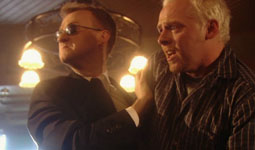 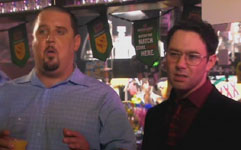
3.11 Doctor Who References
As expected, there are some references to Doctor Who in the King's Evil section of the film.
- The mention of "Deadly Assassin" by the King is a reference to the Tom Baker story, Doctor Who and the Deadly Assassin.
- The mention of Tom Tit (apart from the obvioius rhyming slang) is also a reference to a Doctor Who adventure the Time Monster (1972) and the device called TOMTIT - the Transmission Of Matter Through Interstitial Time.
- There is a homunculous called Mr Sin (aka The Peking Homunculus ) in The Talons of Weng-Chiang (1977).
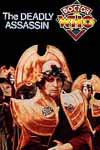
3.12 Geoff's knees clicking
In the series 3 documentary, while impersonating a Lion and Papa Lazarou, Reece complains about his knees clicking. Many fans believe that Geoff's line "Ooo, did you hear me knees click then?" as he is knighted to be a reference to this. Or perhaps Reece just suffers from clicky knees.
3.13 Who art ASDA?
George at ASDA was founded in 1990 when George Davies, decided to start designing a range of clothing specifically for the supermarket chain ASDA. From 5 stores in 1990, there are now over 250 stores within the UK which stock the George at ASDA range and 4 George high street stores in Croydon, Leeds, Preston and Northampton.

|

